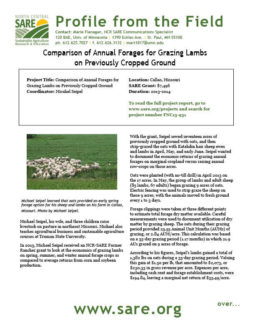Michael Seipel, his wife, and three children raise livestock on pasture in northeast Missouri. Michael also teaches agricultural business and sustainable agriculture courses at Truman State University.
In 2013, Michael Seipel received an NCR-SARE Farmer Rancher grant to look at the economics of grazing lambs on spring, summer, and winter annual forage crops as compared to average returns from corn and soybean production.
With the grant, Seipel sewed seventeen acres of previously cropped ground with oats, and then strip-grazed the oats with Katahdin hair sheep ewes and lambs in April, May, and early June. Seipel wanted to document the economic returns of grazing annual forages on marginal cropland versus raising annual row-crops on those acres.
Oats were planted (with no-till drill) in April 2013 on the 17 acres. In May, the group of lambs and adult sheep (85 lambs, 67 adults) began grazing 9 acres of oats. Electric fencing was used to strip graze the sheep on these 9 acres, with the animals moved to fresh ground every 1 to 3 days.
Forage clippings were taken at three different points to estimate total forage dry matter available. Careful measurements were used to document utilization of dry matter by grazing sheep. The oats during their grazing period provided 25.55 Animal Unit Months (AUMs) of grazing, or 2.84 AUM/acre. This calculation was based on a 35-day grazing period (1.17 months) in which 21.9 AUs grazed on 9 acres of forage.
According to his figures, Seipel’s lambs gained a total of 1,382 lbs on oats during a 35-day grazing period. Valuing this gain at $1.50 per lb, that amounted to $2,073, or $230.33 in gross revenue per acre. Expenses per acre, including cash rent and forage establishment costs, were $194.84, leaving a marginal net return of $35.49/acre.
For the oats that were harvested as hay, the net was a loss of $10.59/acre after mowing, raking, and baling costs were considered.
Seipel learned that annual cover crops (in this case, oats) could be used successfully and economically as a nutrient source for grazing lambs. He also learned that utilization of annual forage crops has risks and is highly weather-dependent and time-sensitive.
“The lessons learned from the grant have generated continued interest from me in finding ways to strategically utilize annual forages,” said Seipel. “Annual forages can play a key role in filling gaps in energy and protein availability left by cool-season perennial pastures. The economic value of livestock weight gains on these forages, while not comparable to returns from annual cash crops during the time the project was completed, are substantial enough that grazing merits consideration, especially with the drop in corn and soybean prices (and returns) that occurred in 2014.”
View Michael's presentation on this project, from the 2016 Farmers Forum, through NCR-SARE's YouTube playlist. Visit www.youtube.com/NCRSAREvideo for this and other videos.
